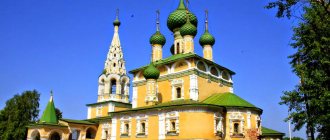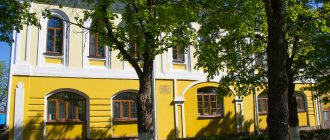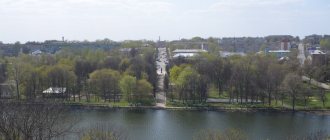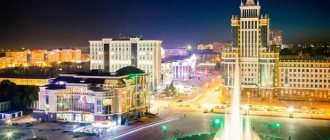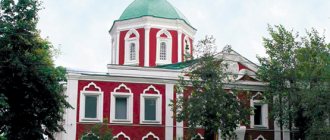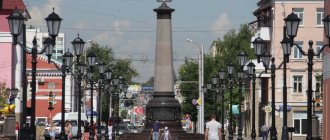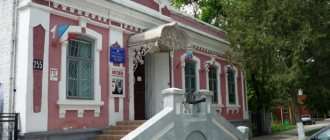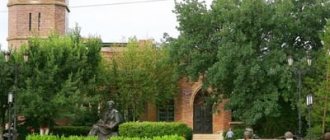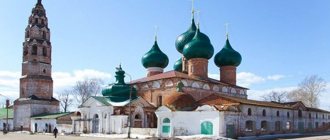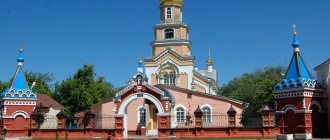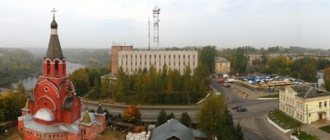Nativity – Mother of God Sanaksar Monastery
After the “Old Town”, on the way to the new one, you can visit the active monastery, which was founded in 1659 not far from the city. The land for it was allocated by the local Temnikovsky nobleman-scribe Luka Evsyukov. A hundred years after its founding, the monastery was closed due to lack of funding.
It was revived in 1764 thanks to Admiral Fyodor Ushakov, who served as its rector for a whole decade, and was buried there. It is interesting that any tourist or pilgrim can stay overnight in the hotel adjacent to the monastery, and completely free of charge. On the territory it is recommended to inspect the cell buildings, chapel, refectory building, carriage house, as well as the fence with a tower and gate.
Population[ | ]
| ↘5400 | ↘1900 | ↗4000 | ↗5500 | ↗6159 | ↗6579 | ↗7354 | |
| 1989[9] | 1992[5] | 1996[5] | 1998[5] | 2000[5] | 2001[5] | 2002[10] | 2003[5] |
| ↗9172 | ↗9500 | ↗9600 | →9600 | ↘9400 | ↘9200 | ↘8375 | ↗8400 |
| 2005[5] | 2006[5] | 2007[5] | 2008[5] | 2009[11] | 2010[10] | 2011[5] | 2012[12] |
| ↘7900 | ↘7800 | ↘7600 | ↘7500 | ↘7328 | ↘7243 | ↘7200 | ↘6975 |
| 2013[13] | 2014[14] | 2015[15] | 2016[16] | 2017[17] | 2018[18] | 2019[19] | 2020[2] |
| ↘6860 | ↘6689 | ↘6489 | ↘6376 | ↘6291 | ↘6179 | ↘5979 | ↘5778 |
As of January 1, 2022, in terms of population, the city was in 1056th place out of 1116[20]cities of the Russian Federation[21].
National composition
As of 2002: Russians - 61.10%, Mordovians - 33.67%, Tatars - 3.31%.
City architectural monuments
Finally we got to Temnikov itself. It is notable for the fact that almost every building in it is an ancient architectural monument of the nineteenth century.
Many buildings are used as residential buildings, some are given over to city government, but there are also those that are completely abandoned. To absorb the spirit of this city, you can simply wander around it. For example, inspect the house in which the composer L. I. Voinov lived and worked (Voinov Street - 7)
He wrote an opera based on the plot of “Tales of the Pope and his worker Balda” by A. S. Pushkin. Or visit the estate of merchant Smirnov on Kommunisticheskaya Street.
There you can also see the ancient buildings of the city government, primary and district schools, almshouses, where a hospital was located during World War II. There are many beautiful buildings on Pervomaiskaya Street. For example, the house in which the public figure, poet and teacher Z. V. Dorofeev lived.
Church of the Assumption of the Blessed Virgin Mary
One of the architectural and historical monuments is the Church of the Assumption of the Blessed Virgin Mary. It was erected in 1827 near the city cemetery. The militia against Napoleon gathered at this place in 1812. It is in memory of these soldiers that the Church was erected.
Location: Penzenskaya street - 2a.
Temnikov
Temnikov is a city and regional center. Located on the Moksha River. 0founded in the 16th century. There is a record about the construction of the city in, dated 7044 (1536) year:. The name is of Turkic origin: temnik - a leader over, that is, over ten thousand people. The name indicates that Tatar military leaders lived in this city. Temnik - a military leader in the horde, later the governor for collecting tribute and governing the region in the conquered Mordovian lands. The town with the name Temnikov was originally built at the end of the 14th century on the left bank of the Moksha River, moved to its present location in 1536, and the former one became known as the village of Old Town. Geographical position.
The city of Temnikov is located in the landscapes of mixed forests of ancient alluvial plains on the river.
Mokshe. The nearest railway station is R. Torbeevo village is located 78 km from the city. Territorial aspects of city development.
In terms of planning, the city is a compact formation located on the right bank of the Moksha.
It is built up mainly with one-story wooden houses with a rare inclusion of two-story public buildings. Blocks of new capital 2, 3, 5-story buildings are located in the eastern part of the city. An industrial and warehouse district has formed in the northeast. The main direction of the territorial development of the city is eastern, since flooded areas are located in the north-west, south and west. Engineering-geological processes.
On the territory of the Temnikovsky district, there are natural prerequisites for the activation of landslides, erosion and karst processes, which can affect the state of geotechnical systems.
Significant damage to the city of Temnikov is caused by the intensively developing lateral erosion of the river. Moksha, accompanied by the destruction of the near-surface zone of the coastal ledge in the form of sloughing and, possibly, small collapses as the river washes away the right bank. The right coastal slope is steep and bare, with the exception of the bottom part. For the period from 1935 to 1987. under the influence of lateral erosion, the bank “receded” eastward up to 100 m (in the section of the river where there is a “direct impact” of the water flow on the coastal slope) at the site of the above-floodplain terrace and up to 55 m within the boundaries of the right-bank floodplain. The rate of coastal retreat during this period reached 2 m per year. The streets of Kirov, Dzerzhinsky, Kuibyshev, Moskovskaya and Lenin fall into the zone of influence of erosion processes. In this regard, it is advisable to construct a dam with simultaneous reclamation and a small diversion of the river bed, which will preserve individual development and make it possible to obtain reserve areas for individual construction. In the suburbs of Temnikov on the Moksha-Alatyr interfluve, manifestations of karst processes are observed. Usually these are basin and depression rounded relief forms, some of which are lakes. No negative impact of karst formation on geotechnical systems has been recorded. The largest area of landslide slopes (about 35 km2) is located on the left bank of Moksha. Activation of landslide processes in April 1995 in the village. Podgornoe Kanakovo led to the destruction of the kindergarten building, boiler house, wastewater treatment plant, and administrative building, which were built on the upper landslide stage in the 1980s. The landslide is active and extends along the slope for a distance of up to 1 km. Groundwater resources and water supply.
The Upper Carboniferous and Upper Carboniferous-Assel aquifers are exploited in the region.
Modern water withdrawal for household and drinking needs does not exceed 8.0 thousand m3/day; large water consumers take 1.0 thousand m3/day. The current demand for water for household and drinking needs is 2.7 thousand m3/day, the future one is 3.7 thousand m3/day. The forecast operational resources of groundwater for the region are 183.6-233.8 thousand m3/day, of which 51.6-57.9 thousand m3/day are not recommended for exploitation (PERWW, concentrated within the Mordovian State Reserve). Water of high drinking quality. Their mineralization varies from 0.3 to 0.4 g/dm3. According to the chemical composition of the water, it is sulfate-hydrocarbonate, chloride-hydrocarbonate, calcium-magnesium, sodium-calcium-magnesium. The total hardness is 3.7-7.1, the removable hardness is 2.2-5.7 mmol/dm3. Fluorine content is 0.5-1.8 mg/dm3. The operational reserves and quality of groundwater can satisfy the needs of any water user. Surface water resources.
The main water artery near the city of Temnikov is the river. Moksha. Observations of its hydrological regime in the section under consideration have been carried out since 1933. The drainage area in the city section is 15,800 km2. The river regime is characterized by high floods with flooding of floodplains, low summer-autumn stable low water, broken in rainy years by two or three floods, and stable winter low water. The spring rise in water level begins under the ice in the third ten days of March - the first half of April. The decline is usually slow, often with secondary peaks. The flood ends in mid-May - early June. Its duration is 1.5-2 months. Summer-autumn low water usually sets in the first half of June and, in the absence of rain, fluctuates between 20-30 cm. The lowest water level is most often observed in August and September. Rain floods are lower than in spring, and flooding of floodplains at this time is a rare phenomenon. Winter low water is stable. It is usually slightly higher than the summer one (10-20 cm). Ice phenomena begin with the formation of grease and banks and occur on average in the first half of November. The river freezes in the third ten days of November - the first ten days of December. The thickness of the ice by the end of winter reaches 55-90 cm, in particularly severe winters - 110 cm. The river breaks up in the first or second ten days of April. Spring ice drift passes quickly - within 3-7 days. Average long-term annual flow of the river. Moksha was calculated based on observations over 67 years: Q0 = 53.7 m3/s, W0 = 1694.8 million m3 per year. Depending on meteorological conditions and the influence of economic activities, significant fluctuations in annual runoff occur. The calculated parameters of the analytical distribution curves characterizing these fluctuations in the considered section of the Moksha River have the following values: coefficient of variation Cv = 0.32; the ratio of the asymmetry coefficient to the coefficient of variation Cs/Cv = 0.6. The distribution of runoff throughout the year is uneven. In an average year in terms of water content, 79% of its annual volume occurs in the spring, 6.5% in winter and 14.5% in summer and autumn. The maximum water flow of the spring flood is the result of a complex interaction of many factors, and, first of all, its value is associated with the process of snow melting and water reserves in the snow. In the section under consideration, according to long-term observations, the maximum water flow rate of the spring flood is Qmax = 1,200 m3/s. The period of minimum flow in the river section under consideration. Moksha is observed in the summer-autumn and winter periods, when the river is fed mainly or exclusively by groundwater. The longer the low water period lasts, the more the riverbed reserves formed by floods or floods are used up, until they are completely depleted and switch to underground feeding. An important characteristic in the practice of water management construction and in environmental assessment of the condition of water bodies is the minimum flow. Therefore, based on the available series of observations, the values of the average monthly minimum flow were calculated, characterizing the regime of summer-autumn and winter low water at the Temnikov site. Currently, surface runoff in the area is almost never used for industrial water supply. In order to create optimal conditions for replenishing groundwater resources, measures should be taken to seasonally regulate the flow of Moksha, using it to replenish the reserves of the Carboniferous-Permian aquifer.
TEMNIKOV , city, district center, before the revolution, district center of the Tambov province. The city of Temnikov is the oldest in Mordovia. The population is predominantly Russian, about 8,700 people. The year of foundation is unknown; many researchers attribute its appearance to the era of the Horde yoke, at the turn of the 14th–15th centuries. In 1536, by decree of Grand Duchess Elena Glinskaya (mother of Ivan the Terrible), it was moved to a new location, upstream of the Moksha River, and rebuilt as a fortress on the edge of Meshchera, as an outpost of Russian colonization between the Moksha and Sura rivers. Since 1572, Temnikov was part of the First Zasechnaya Line along with Shatsk and Alatyr. Then the city was inhabited, along with Russian service people, by Tatar and Mordovian service Murzas “with their people”, but by the middle of the 17th century, the main inhabitants of Temnikov were Russian archers, Cossacks, gunners, artisans and arable soldiers. In the 17th century, due to landslides, the oldest churches in the city were dismantled and moved to other quarters, and the first church, Nikolskaya, was turned into a cemetery. By the beginning of the 20th century, Temnikov owned many magnificent churches and a convent. Under Soviet rule, all the churches were destroyed, except for the Assumption Church, which was reopened during the Great Patriotic War. Currently, there is still one church in Temnikov, the Assumption. The Nativity of the Mother of God Women's Monastery, which lost its churches and was occupied by a vocational educational institution, has not yet been restored.
The Cathedral in honor of the Transfiguration of the Savior and Our Lord Jesus Christ (Spaso-Preobrazhensky) was erected in 1714 in stone to replace the former wooden parish Church of the Transfiguration. The cathedral was repaired and completed many times, even expanded in the main (summer) part. The last major reconstruction dated back to 1840. As a result, from a two-story cathedral it turned into a two-story eight-altared one: on the second floor, the main altar was consecrated in honor of the Transfiguration of the Lord, the side altars - the left one in honor of the Ascension of the Lord, the right one in honor of the Exaltation of the Honorable Cross of the Lord; on the first floor the main altar was dedicated to the Annunciation, the right one to St. Nicholas, Archbishop of Myra, and the left to St. Mitrofan of Voronezh. Two more altars were consecrated in the bell tower - in honor of the Kazan Icon of the Mother of God and in the name of the martyr Theodore Tiron, the latter out of respect for the benefactor who did a lot for the temple - Fedor Evsyukov, a descendant of the founder of the Sanaksar monastery. The main shrine of the cathedral was the locally revered Kazan Icon of the Mother of God (XVIII century). The architectural feature of the temple was its eclecticism; it is unknown in what style it was built at first (most likely under the influence of the “Moscow Baroque”), but the alterations were oriented toward classicism, which was inconsistently maintained. In general, the building turned out to be bulky and not clearly expressed in terms of style. Nevertheless, the Temnikovites loved their cathedral and were proud of it as the largest and most majestic building in the city.
The Church in the name of the Apostle of the Lord John the Theologian (John the Theologian) was built in the 17th century in wood, and in 1863 it was rebuilt in stone, with five chapters, in the image and likeness of the Cathedral of Christ the Savior in Moscow, in the “Tonovsky” style. Type-oriented, it nevertheless carried within itself visible traces of ancient Russian temple-building traditions. The architectural uniqueness of the temple lay in the fact that its winter part, the refectory, was built back in 1820 in the classicism style. The main building turned out to be “attached” to the auxiliary one. Three altars were consecrated in the summer church: the main one in the name of the Apostle John the Theologian, the right one in the name of Elijah the Prophet, and the left one in honor of the Tikhvin Icon of the Mother of God. In the refectory there were two altars - in the name of St. Nicholas, Archbishop of Myra, and in honor of the Intercession of the Most Holy Theotokos. Parishioners especially honored several patronal holidays: Theological on May 8 and September 26, Ilyin's Day on July 20, winter and spring St. Nicholas and Intercession on October 1. The parish consisted of more than 3,600 people, including 1,500 Russian inhabitants of nearby neighborhoods (burghers and artisans), as well as Mordovian-Moksha from the assigned villages of Podgorskoye Konakovo, Shukstelim, Pesochnoye Konakovo, together more than 2100 people. During Soviet times, the temple was used for economic purposes; Over time, it lost most of its components and turned into a building for domestic purposes. Its restoration was considered inappropriate.
The Church in honor of the Life-Giving Trinity (Holy Trinity) was built in stone in the middle of the 18th century. It was completed in 1766 and consecrated at the same time, and in 1793 it underwent a serious alteration: from a two-story building it was turned into a two-story one. On the upper floor, the throne was consecrated in honor of the Life-Giving Trinity, and on the lower floor there were two chapels with thrones in honor of the Kazan Icon of the Mother of God and in the name of the Prophet Elijah. At the beginning of the 19th century, a bell tower was built, and in 1911, in the second tier of the bell tower, a church was built in the name of St. Nicholas, Archbishop of Myra, in memory of “the gracious manifesto of 1905 of Emperor Nicholas II.” The temple was a striking example of Russian provincial baroque and had many shrines revered by the parish, including the Kazan Icon of the Mother of God (18th century), icons of St. Nicholas the Wonderworker, the Great Martyr Panteleimon and the Mother of God “It is Worthy to Eat”, brought from Athos in the late 19th - early 20th century century. The parish included urban inhabitants of the nearest neighborhoods (Russians), about 3,000 people, as well as residents of six suburban villages: Ityakovo, Karaevo, Tyuveevo, Sosnovka, Safonovka, Valza. During Soviet times, the church was destroyed.
The Church in honor of the Entry of the Most Holy Theotokos into the Temple (Vvedenskaya) was built as a winter church at the Holy Trinity Church, in close proximity to it. The benefactors were members of the Ponomarev merchant family. The main work in the temple was completed in 1855, and the bell tower was erected at the beginning of the twentieth century. The temple was designed in the New Russian style, characteristic of Russia in the second half of the 19th century. Initially, one altar was consecrated in the church, the Vvedensky altar, and in the 1880s two more altars appeared in the refectory - on the right in the name of John the Baptist, on the left in the name of the apostles Peter and Paul. During Soviet times, the church was destroyed.
The Church in the name of St. Nicholas, Archbishop of Myra (Nikolskaya) had a difficult history. The ancient wooden church in the name of St. Nicholas the Pleasant was built, as many local historians believed, back in the 16th century as a cathedral, but then it gave way to the new stone St. John the Theological Church, and the role of the cathedral to the Transfiguration Church, built on the same square as the voivodeship board The Temyans demolished the former St. Nicholas Church, as it had become very dilapidated over several decades. This happened no later than 1635, when it ceased to be included in the registers. In 1628, it was still listed as a cathedral “ruzhnaya”, that is, it received a rug and food allowance from the Patriarchal Court. While retaining the name of the cathedral for some time, the St. Nicholas Church nevertheless barely glimmered, because the settlement of the city went in a different direction, and the former center gradually turned into the outskirts. In 1697, the rector Lazar complained to the State Prikaz that “that St. Nicholas Church of the parish people does not have a single courtyard, and he (the rector - S.B.) feeds on the alms of those people who come to that church and, on promise, pray and offer prayers Image of the Wonderworker Nikolaev." We were talking about a new temple, built in the 1640s. In March 1700, the Patriarchal order issued an antimension “to the city of Temnikov for the Church of St. Nicholas the Wonderworker” to a trusted person who arrived in Moscow, the priest of the Kazan Church, Moses Pavlov. This means that the metropolitan authorities decided to completely demolish the former St. Nicholas Church and ordered the construction of a new one in another place, “which the townsfolk and residents will desire.” So the St. Nicholas Church was born for the third time, this time in stone, which, however, did little to help the temple. During the era of Peter I and his immediate successors, the temple languished, and it acquired a small parish only at the beginning of the 19th century. At the beginning of the 18th century, a churchyard grew around the church. Subsequently, the church was officially considered a cemetery. The inhabitants of Temnikov, back in the 18th century, intended to establish a city monastery at the temple, capable of replacing the fading Sretenskaya (Sanaksarskaya) hermitage, but the good intention had no result. During the time of Empress Anna Ioannovna, townspeople wrote in a petition to St. Petersburg: “... and in Temnikov, the ancient abandoned church of St. Nicholas the Wonderworker on the abandoned city site is without a parish... and the city place and the cathedral church were abandoned for that reason from the fire time and from the arrival of spring water, the ditches were washed and dug , and many towers burned and fell, and the city fortresses were damaged, and the cathedral church, by decree, was again built in Temnikov on the settlement, and the city site, by decree, was again allocated and the design was made in Temnikov in another place on the Moksha River on Isineeva Mountain, according to the decree, that place was allocated and the drawing was made by a messenger, sent from Moscow, Fyodor Ivanov, the son of Lovchikov, and that allotment and drawing are still in Temnikov in the office of the voivodship government, and in that deserted place and at that ancient cathedral St. Nicholas church it is fitting for the monastery to be... " Why the townspeople abandoned their idea remains unclear. Before its demolition under Soviet rule, St. Nicholas Church remained a cemetery, attached to the Transfiguration Cathedral. In architectural terms, it was a monument to ancient Russian styles; The bell tower, built in the 19th century, bore the features of classicism.
The Mariinsky Church (house) existed at the almshouse established by the Bochkarev merchant family. The same family also acted as benefactors of the temple, built in 1887. The locally revered icon of the Mother of God “Joy of All Who Sorrow” was kept in the Mariinsky Church.
The church in honor of the Dormition of the Blessed Virgin Mary (Uspenskaya), wooden, existed since the 17th century; Assumption priests were mentioned in documents from the Razin region (1670-71); its location has not been established; it is known that this temple was erected on a settlement, at a distance from the fortress, which was washed away by the Moksha River and threatened with collapse. In the 18th century, the Assumption Church burned twice and was restored again, but at the end of the century it was no longer there. However, the Temnikovites always had plans to revive the temple in the best possible way. A new church, again in memory of the Dormition of the Blessed Virgin Mary, made of stone, was erected in 1827 near the new cemetery, on the site where the Temnikov militia warriors going to war with Napoleon gathered. The temple was conceived as a monument to soldiers who died for the Fatherland. The architectural features of the church, built in the classicist style, are now rated very highly by experts. There were three altars: the main Assumption throne was supplemented by two more chapels, in the refectory - the right one in the name of St. Nicholas, Archbishop of Myra, and the left one in the name of the Great Martyr Paraskeva. Of the previous icons, the image of the Mother of God “The Sign” was considered especially revered. Taken from believers by the Soviet authorities, the Assumption Church was returned to the parish during the Great Patriotic War. This is one of the few active churches that survived in Mordovia in the decades preceding the creation of the Saransk and Mordovian diocese. The temple was renovated several times (most recently for the celebrations of the 1000th anniversary of the baptism of Rus'). Currently, among the icons, the image of the Mother of God “Unexpected Joy” is especially revered by parishioners.
Literature: Chernukhin A. A. Temnikov. – Saransk, 1971; Andrievsky A. E. Historical and statistical description of the Tambov diocese. – Tambov, 1911; Kholmogorov V. and G. Materials for the history, statistics and archeology of the city of Temnikov and its district XVII–XVIII centuries. – Tambov, 1890; Nartsov A. N. Archaeological trip to Temnikovsky district. // News of the Tambov Scientific Archival Commission, vol. XLVI. – Tambov, 1902; Historical and archaeological map of the Tambov province. // News of the Tambov Scientific Archival Commission, vol. 50. – Tambov, 1905, p. 67-68; Yamushkin V. P. On the history of the city of Temnikov and its district // Notes of the MNIYALIE, vol. 15. – Saransk, 1952; Bakhmustov S. B. Monasteries of Mordovia. - Saransk, 2000; Voronin I. D. Sights of Mordovia. – Saransk, 1972.
BAKHMUSTOV Sergey Borisovich ORTHODOX PARISH CHURCHES OF MORDOVIA, Dictionary-reference book, 2015.
Temnikovsky Museum of History and Local Lore named after F. F. Ushakov
If you are going to explore any city, you should definitely visit the local history museum in order to get to know its history and culture better. There is one in Temnikov too. It was founded in 1901 by a noble assembly, which included such famous families as the Demidovs, Obolenskys, Novosiltsevs, Ushakovs, Romanovskys, Churilovs and others. Among them, the Kulunchaks are the grandparents of A.I. Kuprin.
The museum contains truly valuable and unique exhibits. For example, an ancient Russian sword from the 10th - 11th centuries, leather shoes from the 16th century, tips of ancient spears, arrows and axes, medieval weapons, original portraits, paintings and much more.
Location: Kommunisticheskaya street - 19.
